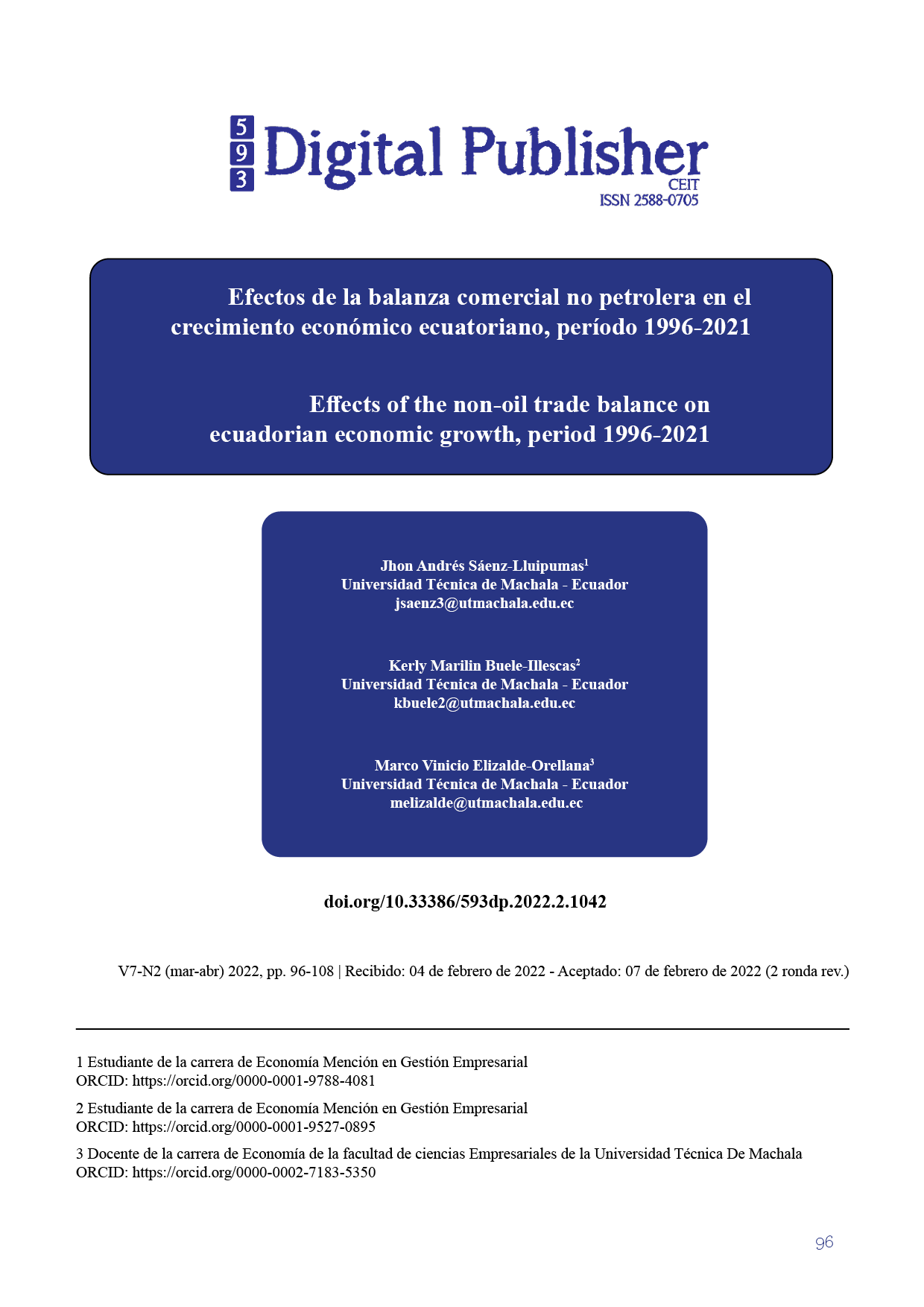Effects of the non-oil trade balance on ecuadorian economic growth, period 1996-2021
Main Article Content
Abstract
In Ecuador, the non-oil trade balance is an important variable because it records the purchase (imports) and sale (exports) of raw materials such as bananas, coffee, shrimp, and roses, which allows determining the prosperity, recession, or economic decline of the non-oil sector. Due to this importance, the present research is developed with the objective of "analyzing the effect of the non-oil trade balance in the Ecuadorian economic growth during the period 1996 - 2021" for the analysis we used data from official sources (BCE and World Bank), with which a "log-log" model was elaborated, on the other hand, using the function of the "log-log" model. On the other hand, using the Cobb Douglas production function, it was determined whether the Non-oil Trade Balance generates increasing or decreasing returns to scale.
One of the theories that justify the development of this research is "Thirlwall's Law", whose specification describes the behavior and variation of exports and the income elasticity of imports as a function of economic growth. The econometric analysis was carried out using the Stata program, which showed important results showing that the non-oil trade balance (Exports and Imports) is significant and presents an important contribution within the Ecuadorian economic growth, on the other hand, imports influenced more than exports within it, however, according to the Cobb Douglas production function, the non-oil trade balance generates an economy with diminishing returns to scale.
Downloads
Article Details

This work is licensed under a Creative Commons Attribution-NonCommercial-ShareAlike 4.0 International License.
1. Derechos de autor
Las obras que se publican en 593 Digital Publisher CEIT están sujetas a los siguientes términos:
1.1. 593 Digital Publisher CEIT, conserva los derechos patrimoniales (copyright) de las obras publicadas, favorece y permite la reutilización de las mismas bajo la licencia Licencia Creative Commons 4.0 de Reconocimiento-NoComercial-CompartirIgual 4.0, por lo cual se pueden copiar, usar, difundir, transmitir y exponer públicamente, siempre que:
1.1.a. Se cite la autoría y fuente original de su publicación (revista, editorial, URL).
1.1.b. No se usen para fines comerciales u onerosos.
1.1.c. Se mencione la existencia y especificaciones de esta licencia de uso.
References
guilar, P., Maldonado, D., & Solorzano, S. (06 de febrero de 2020). Incidencia de la balanza comercial en el crecimiento económico del Ecuador: análisis econométrico desde Cobb Douglas, período 1980-2017. Espacios, 41(03), 10. Obtenido de http://www.revistaespacios.com/a20v41n03/20410310.html
Arévalo, G. A. (15 de Septiembre de 2014). Ecuador: economía y política de la revolución ciudadana, evaluación preliminar. Scielo, 33(58), 109-134. Obtenido de http://www.scielo.org.co/scielo.php?pid=S0120-30532014000200005&script=sci_abstract&tlng=es
Banco Central del Ecuador. (2010). La Economía Ecuatoriana Luego de 10 Años de Dolari. Obtenido de Banco Central del Ecuador: https://contenido.bce.fin.ec/documentos/PublicacionesNotas/Notas/Dolarizacion/Dolarizacion10anios.pdf
Banco Central del Ecuador. (1 de September de 2016). LA ECONOMÍA ECUATORIANA CRECIÓ EN 0.2% EN EL 2015. Recuperado el 23 de January de 2022, de Banco Central del Ecuador: https://www.bce.fin.ec/index.php/boletines-de-prensa-archivo/item/909-la-econom%C3%ADa-ecuatoriana-creci%C3%B3-en-02-en-el-2015
Banco Central del Ecuador. (31 de Julio de 2018). Banco Central del Ecuador. Obtenido de El BCE actualiza la cifra de crecimiento de la economía en el 2017: https://www.bce.fin.ec/index.php/boletines-de-prensa-archivo/item/1113-el-bce-actualiza-la-cifra-de-crecimiento-de-la-econom%C3%ADa-en-el-2017
Banco Central del Ecuador. (Septiembre de 2021). Banco Central del Ecuador. Obtenido de Ecuador registra un crecimiento interanual de 8,4% en el segundo trimestre de 2021: https://www.bce.fin.ec/index.php/boletines-de-prensa-archivo/item/1447-ecuador-registra-un-crecimiento-interanual-de-8-4-en-el-segundo-trimestre-de-2021
Banco Central del Ecuador. (s.f.). Información Estadistica Mensual. Recuperado el 17 de January de 2022, de Información Económica: https://contenido.bce.fin.ec/home1/estadisticas/bolmensual/IEMensual.jsp
Banco Mundial. (s.f.). Obtenido de https://datos.bancomundial.org/indicator/NY.GDP.MKTP.CD
Bayas Mancheno, N. (12 de Mayo de 2017). Factores Determinantes del Crecimiento Económico en los Países de Ingreso Medio. UNIVERSIDAD SAN FRANCISCO DE QUITO USFQ, 1-36. Obtenido de https://repositorio.usfq.edu.ec/handle/23000/6392
Briones Mendoza, ,., Molero Oliva, L., & Calderón Zamora, O. (Julio - Diciembre de 2018). La función de producción cobb-douglas en el ecuador. Bibliografia Latinoamericana en revistas de investigación científicas y social, 19(2), 45-73. Obtenido de https://biblat.unam.mx/es/revista/tendencias/articulo/la-funcion-de-produccion-cobb-douglas-en-el-ecuador
Camargo Mayorga, D., Cardona García, O., & González Guzmán, J. (2018). https://dialnet.unirioja.es/servlet/articulo?codigo=6525208. Un acercamiento empírico a la función de producción de compost para 33 países, 1(1). Obtenido de https://dialnet.unirioja.es/servlet/articulo?codigo=6525208
Cedillo, L. F., Jumbo, M. K., & Campuzano, J. A. (2018). Crecimiento económico del Ecuador: análisis econométrico desde Cobb Douglas, período 1990-2016. Espacios, 6. Obtenido de http://www.revistaespacios.com/a18v39n47/18394706.html#:~:text=La%20funci%C3%B3n%20de%20producci%C3%B3n%20Cobb,capital%20(Mankiw%2C%202014).
Cepal. (2021). Cepal. Obtenido de Estudio Económico de América Latina y el Caribe: https://repositorio.cepal.org/bitstream/handle/11362/47192/68/EE2021_Ecuador_es.pdf
Chamba Bernal, J., Bermeo Cuenca, L., & Campuzano Vásquez, J. (01 de Mayo de 2021). Variables determinantes en el crecimiento económicodelEcuador funciónCobb-Douglass 2007-2019. Sociedad & Tecnología, 4(2), 110-122. Obtenido de https://institutojubones.edu.ec/ojs/index.php/societec/article/view/98/328
Feijoo, J. C., García, S., Tenelanda, D., & Pico, J. (20 de Marzo de 2020). Balanza Comercial y Producto Interno Bruto en Ecuador. RevicyhLUZ-Portal de Revistas Científicas y Humanísticas. Obtenido de https://produccioncientificaluz.org/index.php/rvg/article/view/33395/35190
Garduño Román, S. A. (Junio - Diciembre de 2002). ENFOQUES METODOLÓGICOS EN LA INVESTIGACIÓN EDUCATIVA. Investigación Administrativa, 1(30), 14-16. Obtenido de https://www.ipn.mx/assets/files/investigacion-administrativa/docs/revistas/90/ART2.pdf
Gonzales, P., & Nina, D. (15 de Abril de 2018). La función de producción Cobb Douglas y su aplicación en la economía boliviana. INNOVA, 3(4), 70-82. Obtenido de https://revistas.uide.edu.ec/index.php/innova/article/view/495
Guillen, A., Badii, M., Garza, F., & Acuña, M. (01 de Abril de 2015). Descripción y Uso de Indicadores de Crecimiento Económico. Daena: International Journal of Good Conscience, 10(01), 139-157. Obtenido de http://www.spentamexico.org/v10-n1/A10.10(1)138-156.pdf
Gujarati, D., & Porter, D. (2010). La función de producción Cobb-Douglas: más sobre la forma fun-cional. McGraw-Hill.
Heras, D. (03 de febrero de 2019). ANÁLISIS DE LA BALANZA COMERCIAL PETROLERA Y NO PETROLERA DEL ECUADOR DURANTE EL PERIODO 2013-2017. Universidad Técnica de Machala. Obtenido de http://repositorio.utmachala.edu.ec/bitstream/48000/13418/1/ECUACE-2019-AE-DE00429.pdf
Jumbo Ordóñez, D., Campuzano Vásquez, J., Vega Jaramillo, F., & Luna Romero, Á. (02 de diciembre de 2020). Crisis económicas y covid-19 en Ecuador: impacto en las exportaciones. Scielo, 12(6). Obtenido de http://scielo.sld.cu/scielo.php?script=sci_arttext&pid=S2218-36202020000600103
Ley Larrea, I. (01 de 06 de 2015). "LOS DETERMINANTES DE LAS IMPORTACIONES Y SUS EFECTOS EN LA BALANZA COMERCIAL NO PETROLERA DEL ECUADOR. PERÍODO 2007 – 2013”. Universidad de Guayaquil, 90. Obtenido de http://repositorio.ug.edu.ec/bitstream/redug/8327/1/TESIS%20INGRID%20ZAYLI%20LEY%20LARREA.pdf
Montesino, J. L. (Enero de 2008). LA ECONOMÍA ECUATORIANA DEL SIGLO XXI Y SUS PERSPECTIVAS DE COMERCIO INTERNACIONAL CON PAÍSES DEL ASIA PACÍFICO. Redalyc, IX(1), 71-101. Obtenido de https://www.redalyc.org/pdf/3379/337930326004.pdf
Müggenburg Rodríguez, M., Pérez Cabrera, & Iñiga. (Enero de 2007). Tipos de estudio en el enfoque de investigación cuantitativa. Redalyc, 4(1), 35-38. Obtenido de https://www.redalyc.org/pdf/3587/358741821004.pdf
Naranjo Chiriboga, M. P. (30 de Noviembre de 2017). INCIDENCIA DE LA DOLARIZACIÓN SOBRE LA ECONOMÍA ECUATORIANA, 2000 - 2015*. Redalyc, 21(46), 95-112. Obtenido de https://www.redalyc.org/journal/1650/165060168004/html/
Reyes, A. A., & Aguirre, D. S. (2016). CRECIMIENTO DE LA ECONOMÍA ECUATORIANA: EFECTOS DE LA BALANZA COMERCIAL NO PETROLERA Y DE LA DOLARIZACIÓN. ESCUELA SUPERIOR POLITÉCNICA DEL LITORAL. Obtenido de http://www.dspace.espol.edu.ec/xmlui/bitstream/handle/123456789/36500/D-CD194.pdf?sequence=-1&isAllowed=y
Rojas Cairampoma, M. (2015). Tipos de Investigación científica: Una simplificación de la complicada incoherente nomenclatura y clasificación. Redalyc, 16(1), 1-14. Obtenido de https://www.redalyc.org/pdf/636/63638739004.pdf
Roura, A. M. (9 de January de 2020). ¿Por qué sigue siendo tan popular la dolarización entre los ecuatorianos? (y cuál es su lado oscuro). BBC. Obtenido de https://www.bbc.com/mundo/noticias-america-latina-50916554
Thirlwall, A. P. (1979). “The balance of payments constraints as an explanation of international growth rate differences”. Banca Nazionale del Lavoro Quarterly.
Thirlwall, A. P. (2003). La Naturaleza Del Crecimiento Económico: Un Marco Alternativo Para Comprender el Desempeño de Las Naciones. Fondo de Cultura Económica.
Torres Freire, M., & Campuzano Vásquez, J. (2021). Impacto de la Balanza Comercial en el crecimiento económico ecuatoriano, período 1990-2019. Ciencia y Tecnología UPSE, 8(1), 42-47. Obtenido de https://incyt.upse.edu.ec/ciencia/revistas/index.php/rctu/article/view/554
Torres Pérez, R. (2015). El sector externo y el desarrollo económico. Oportunidades y retos para Cuba. Redalyc, 155(2), 60-74. Obtenido de https://www.redalyc.org/pdf/4255/425543135005.pdf




